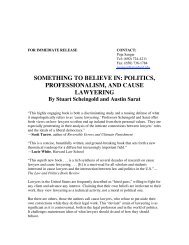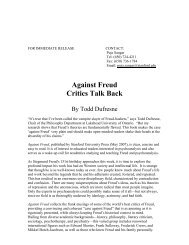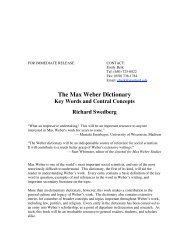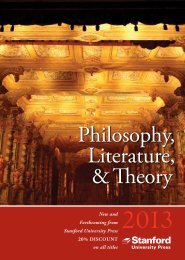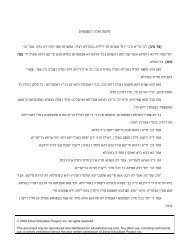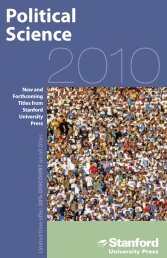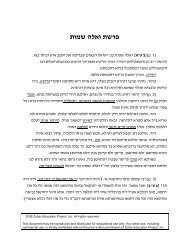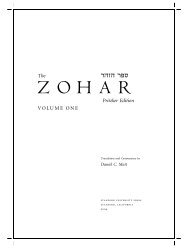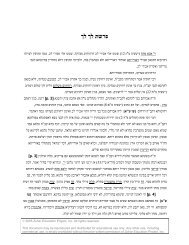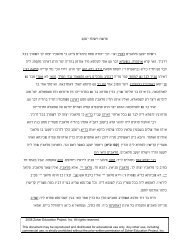Chapter 1 (PDF) - Stanford University Press
Chapter 1 (PDF) - Stanford University Press
Chapter 1 (PDF) - Stanford University Press
You also want an ePaper? Increase the reach of your titles
YUMPU automatically turns print PDFs into web optimized ePapers that Google loves.
in the third to be one without division. 209 From the fourth day on, its<br />
included<br />
was revealed, yielding an artisan for each and every skill, 210 forthe fourth<br />
work<br />
both earlier and later days, was dependent on the Sabbath day, 212 as is<br />
them,<br />
God included in 213 the seventh day His work that He had made (Genesis<br />
written:<br />
This is Sabbath, fourth leg of the throne.<br />
2:2).<br />
you might ask, `If so, why My Sabbaths you are to observe, two?' The<br />
``Now<br />
the Sabbath of Sabbath eve and the Sabbath of the day itself, which<br />
answeris:<br />
indivisible.'' 214<br />
are<br />
said, ``What is the holiness of the Sabbath?''<br />
He<br />
replied, ``This is the holiness drawn down from above.''<br />
He<br />
symbolize the quartet of sefirot:<br />
elements<br />
Gevurah, Tif'eret, and Shekhinah.<br />
Ḥesed,<br />
included in the third . . . The third<br />
209.<br />
day is Tif'eret, the male sefirah.<br />
primordial<br />
activity of the female, Shekhinah, symbolized<br />
The<br />
by earth, took place on the fourth<br />
but is included in His day to ensure and<br />
day<br />
their union.<br />
demonstrate<br />
From the fourth day on...an<br />
210.<br />
. . . Beginning on the fourth day,<br />
artisan<br />
lowertriad of sefirot emerged: Netsaḥ,<br />
the<br />
and Yesod. These three artisans com-<br />
Hod,<br />
the work of the preceding skilled trio:<br />
pleted<br />
Gevurah, and Tif'eret. See OY.<br />
Ḥesed,<br />
fourth leg . . . The four sefirot<br />
211.<br />
Gevurah, Tif'eret, and Shekhinah),<br />
(Ḥesed,<br />
fourelements, also constitute the four<br />
the<br />
of the divine throne upon which sits<br />
legs<br />
SeeZohar 1:20a.<br />
Binah.<br />
earlier and later days...Sabbath<br />
212.<br />
completes the triad of Ḥesed, Gevurah,<br />
Shekhinah<br />
and Tif'eret, as well as the next triad:<br />
Hod, and Yesod. She is the Sabbath,<br />
Netsaḥ,<br />
of the primordial week of<br />
culmination<br />
Sabbath of Sabbath eve . . . There<br />
214.<br />
two aspects of the Sabbath: the feminine<br />
are<br />
eve, symbolized by Shekhinah, and<br />
Sabbath<br />
masculine Sabbath day, symbolized by<br />
the<br />
or Yesod. Cf. Moses de Leo n, Sefer<br />
Tif'eret<br />
1±10.<br />
ha-Mishqal,<br />
Arab merchant, traveler,'' apparently<br />
``Arab,<br />
from the name of the Arabian tribe<br />
derived<br />
The prophet Elijah returns to earth to<br />
taiy.<br />
a tayya'a in BT Berakhot 6b, and as<br />
appearas<br />
Rosh ha-Shanah 26b; Yevamot 120b;<br />
See<br />
Batra 73b; Sanhedrin 110a; Ḥullin 7a.<br />
Bava<br />
the Zohar, tayya'a indicates one of several<br />
In<br />
wandering donkey-drivers who annoy,<br />
and enlighten the Companions on<br />
perplex,<br />
road. See 2:45b, 94b±114a, 145b, 155b±157a;<br />
the<br />
186b; ZḤ 83a±d (MhN, Rut); TZ 23,<br />
3:21a±23a,<br />
Cf. Tosefta, Ḥagigah 2:1 (BT Ḥagigah 14b;<br />
69a.<br />
Ḥagigah 2:1, 77a); BT Mo'ed Qatan 25a±b;<br />
JT<br />
Rabbah 32:10; Shir ha-Shirim Rabbah<br />
Bereshit<br />
4:3; Steinschneider, Polemische und apologetische<br />
on<br />
Literatur, 248±54; Pushinski, in<br />
2 (1940): 140±47; Scholem, Major<br />
Yavneh<br />
165, 388, n. 46; idem, Kabbalah, 227.<br />
Trends,<br />
My sanctuary . . . The continuation<br />
216.<br />
the verse with which Rabbi El'azar open-<br />
of<br />
My Sabbaths you are to observe . . .<br />
ed:<br />
19:30).<br />
(Leviticus<br />
Haqdamat Sefer ha-Zohar<br />
[1:5b]<br />
day constitutes the fourth leg of the celestial throne. 211<br />
All the work of all of<br />
That Arab donkey-driver 215<br />
goading behind them said, ``And what is My<br />
you are to hold in awe (Leviticus 19:30)?'' 216<br />
sanctuary<br />
replied, ``This is the holiness of the Sabbath.''<br />
He<br />
31<br />
TKK<br />
B<br />
(Tayya'a),<br />
215. Arab donkey-driver J<br />
K (aravi), ``Arab'' in Rut Zuta 1:20; 4:11.<br />
CZ<br />
an<br />
T<br />
Creation.<br />
included G MK N<br />
213.<br />
(Vaykhal), ``And He<br />
(klh). Rabbi<br />
from the root M N F<br />
completed,''<br />
El'azarunderstands this word in light of the<br />
related root<br />
M<br />
N<br />
N<br />
(kll), ``include, comprise,<br />
gather.''



